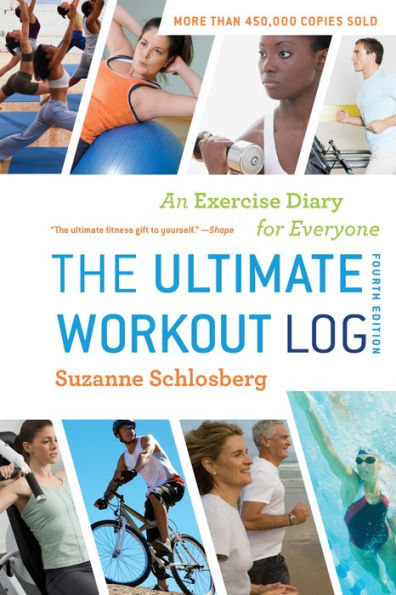Read an Excerpt
Introduction to the Third Edition
You asked for it—you got it!
The log you’re holding has undergone a major makeover since the second edition, thanks to all the loyal users who have taken the time to post suggestions online or to e-mail me personally. Redesigning the log wasn’t tough, since just about everyone made the same request: add more space. OK—done! The third edition has everything you’ve asked for—more room for strength-training notes, a designated section for yoga or Pilates, a bigger box for nutrition notes, and a special "Daily Wrap-up” area to record overall feelings and impressions. If you’ve used previous editions of this log, you’ll notice the most significant change right off: there’s now an entire page for each day of the week.
But the page design isn’t all that’s new. The third edition is filled with intriguing nuggets of research and fitness trivia that you can toss around at your next Spinning class or group hike. Any idea how the dumbbell got its name? Or what about the origins of the term "bikini”? You’ll find out in Week 5 and Week 8, respectively. And guess who can run faster: a world-class sprinter or a kangaroo? The answer appears in Week 2. Plus every Saturday there’s a mini nutrition quiz. (Which has more calcium: a cup of yogurt or a cup of spinach? Find out in Week 4.) You’ll cap off each week with words of wisdom from an accomplished athlete.
WHY KEEP A LOG?
This log may look different from previous editions, but its purpose remains the same: to help you stay motivated, achieve your fitness goals, and feel a sense of accomplishment. Whether you’re aiming to finish your first triathlon, set a personal bench-press record, or simply fit back into jeans you’ve outgrown, your log will help you get results. It will reveal patterns in your training and help you discover how much exercise—and how much rest—is right for you. And it will prod you to set goals that are concrete and realistic while devising strategies to reach them.
Can a bunch of blank pages really do all that? "The mere fact of writing something down makes you more committed to it,” says sports psychologist Robert Weinberg, Ph.D., a professor at Miami University in Ohio, who has done extensive research on goal setting and athletic performance. When it comes to setting goals, Weinberg’s motto is: "Ink it, don’t think it!” I second the motion.
Many of the world’s best athletes are diehard believers in recording their goals and tracking their workouts. "Keeping a training log is invaluable,” says 2004 Olympic marathoner Alan Culpepper. "It is the best way to truly dissect and reflect on those things that worked well and those that did not. It also keeps you honest. You have to have some way to monitor your training to make sure you’re not neglecting or overemphasizing one area.” As Culpepper points out, it’s so easy to forget what you did two weeks ago, or even two days ago.
Of course, you needn’t be a world-class athlete to learn from your log. In fact, newbies may even have the most to gain. Jayne Williams, author of Slow Fat Triathlete, records not just her mileage but also her sleep quality, fatigue, soreness, stress level, and overall well-being. "It makes me pay attention to what’s going on in my life as a whole,” Williams told me. "If I’ve been up half the night watching cheesy movies, I shouldn’t be surprised that I don’t feel fresh for my run the next day.” Your log not only will help you adjust your training but also will boost your confidence by reminding you of all that you’ve accomplished. Deena Kastor, a 2004 Olympian and the American record holder in the women’s marathon, highlights her exceptional workouts so they’ll stand out when she flips back through her log before a competition. "I get energized to bring back the emotion of the great days,” she says.
Champion wheelchair racer Jean Driscoll considers her training journals to be nothing less than personal treasures. "They are a record of what I’ve done, where I’ve been, who I am, and where I can go,” says Driscoll, a two-time Olympic silver medalist and eight-time Boston Marathon winner. "They are as much a training partner to me as my teammates are.” My own log served as a confidence booster not long ago, after I broke my tailbone—ouch!—in a cycling accident. When I learned that I’d be forced off the bike for six weeks—double ouch!—I worried, as injured exercisers usually do, that my hard-earned fitness was going to vanish overnight. I moped and whined for a few days, but then, in a more rational moment, I flipped through my log and saw how consistently I’d been training for many months. Clearly, I’d built a solid base that was likely to carry me through. I reminded mysellf that you can’t lose your fitness the way you can lose your car keys!
Once my tailbone healed, it did take me three or four weeks to get back up to speed. At first, even cycling short hills left me gasping for breath, and there were days when all I wrote in my workout log was "Ugh!” and "#$% *$#!” But before long, I was back in form, making notes like "felt strong!” and "awesome workout!” My hope is that you’ll have plenty of awesome workouts to record in this log. I welcome feedback on this new edition.
Copyright © 2005 by Suzanne Schlosberg. Reprinted by permission of Houghton Mifflin Company.



